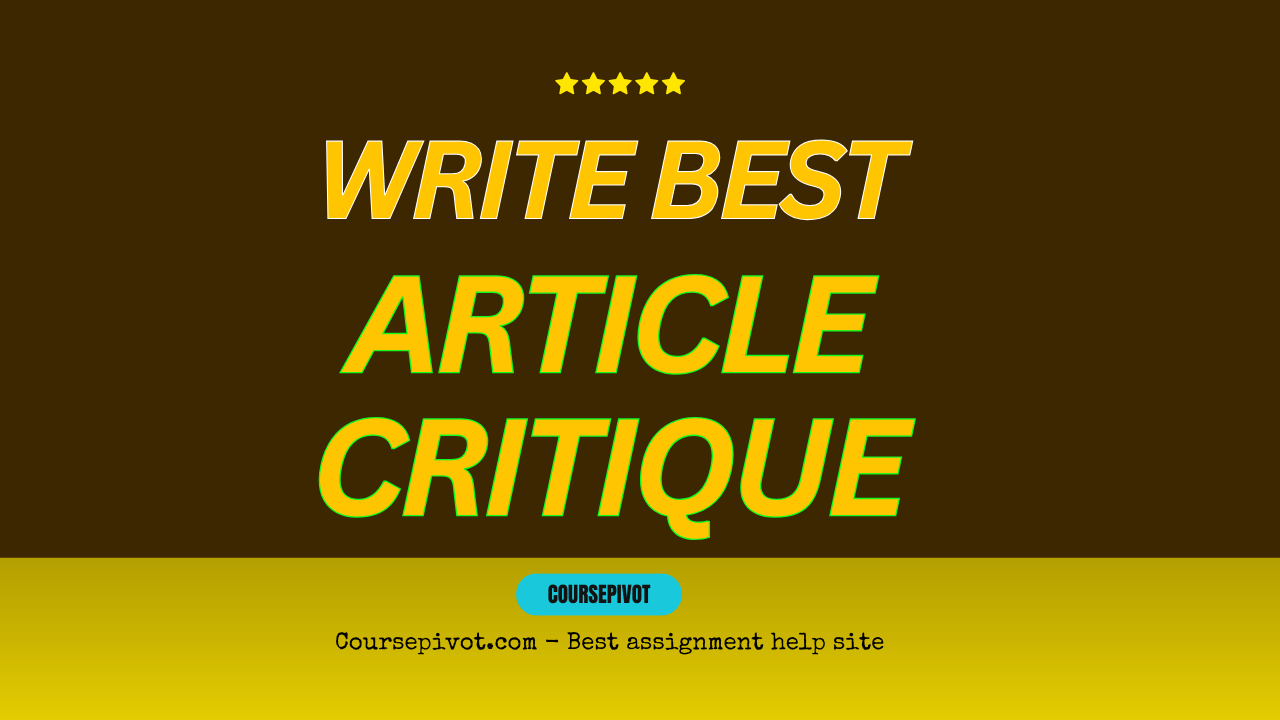Journal Article Critique Example – How to Critique an Article in APA

Before, we begin, have I written journal article critiques and how do I manage this assignment type? To write the best journal critique papers, I’ve really focused on a few key things. First, I always read the article multiple times, making notes and highlighting key points. I try to put myself in the author’s shoes, understanding their perspective, but also looking for gaps in their reasoning. Then, I spend a lot of time analyzing the methods and evidence, asking myself if they’re sound and if the conclusions really follow. Finally, I make sure to connect the article to broader themes in the field, showing that I understand its significance. It’s a process of deep engagement, and honestly, it’s helped me become a much more critical and thoughtful reader.
What’s a Journal Article Critique?
A journal article critique is essentially your thoughtful review of someone else’s published research. You’re not just summarizing; you’re digging deeper, analyzing their arguments, methods, and conclusions. Think of it as a critical conversation with the author.
Why Write It as a Student?
As a student, writing critiques helps you sharpen your critical thinking skills. You learn to evaluate information, spot weaknesses in arguments, and understand how research contributes to a field. It’s like training your academic “detective” skills.
Purpose of the Assignment
Professors assign critiques to see if you can:
- Understand complex research.
- Analyze and evaluate arguments.
- Form your own informed opinions.
- Write clearly and professionally.
Basically, they want to know if you’re developing the skills needed for graduate-level work.
Can I Pay Someone to Do a Journal Article Critique?
Yes, you can pay someone to write your journal critique. Coursepivot.com, as the best assignment writing website, offers assignment help, and they promote that they have skilled writers who can handle critique papers.
A Journal Article Critique Sample (2025)
Critique of Khalaf et al. (2023): The Impact of Social Media on the Mental Health of Adolescents and Young Adults: A Systematic Review
Part 1: Summary Paragraph
Khalaf et al. (2023) conducted a systematic review to explore the complex relationship between social media usage and the mental health of adolescents and young adults. The authors examined studies from 2000 to 2023, analyzing the potential risks such as cyberbullying, sleep disruption, and increased mental distress, while also acknowledging the benefits of social connection and information access. The review highlighted the challenges in measuring social media impact due to self-reporting biases and the need for more longitudinal studies to establish causality and understand the nuanced effects of diverse social media behaviors.
Part 2: Analysis of Author’s Key Points
The authors effectively synthesized a broad range of studies, revealing a general correlation between increased social media usage and negative mental health outcomes, particularly among adolescents. However, the review also underscored the inconsistency of findings, echoing concerns raised by Rideout and Fox (2018) regarding the “generally correlated” link between social media and depression, and the frequent poor data quality. The discussion around active versus passive social media use, while acknowledged as a potential false dichotomy, lacked a more critical examination of the underlying motivations behind different user behaviors, as suggested by Przybylski and Weinstein (2017) who emphasize the importance of understanding the context of technology use. Furthermore, while the authors highlighted the dangers of cyberbullying and peer pressure, they could have expanded on the specific vulnerabilities of marginalized groups, aligning with Moreno and colleagues’ (2011) findings on the heightened risks for LGBTQ+ youth. The reviews focus on the negative effects of social media, but does not provide adequate research on the benefits that social media can provide, such as community building.
Part 3: Personal Response
I found the review’s emphasis on the need for nuanced research to be particularly insightful. The authors correctly pointed out the limitations of self-reporting and the necessity for longitudinal studies to establish causality. I agree that the complexity of social media’s impact demands a more granular approach, considering the diverse behaviors and motivations of users. As a student, I recognize that the rapid evolution of digital platforms necessitates continuous research to understand their effects on mental health. I believe the authors’ call for open, nonjudgmental strategies for clinicians to work with young people and their families is essential. One can see that the findings of this review can inform future studies, and also provide a basis for mental health professionals to better understand the impact of social media. I also feel that the authors should have provided more in depth information on how social media can be used in a positive manner.
NB: This is not an original work, if you want someone to do your article critique paper or any other assignment from scratch with 0% AI guarantee, please order yours from our US assignment helpers.
Remember the cover/title page of an APA formatted paper has the following details:
- Title of the Critique: Concise and reflective of the article’s topic.
- Your Name
- Affiliation (e.g., University Name, Department)
- Course Number and Name
- Instructor’s Name
- Due Date
How to Write a Journal Article Critique in APA, Step by Step
Body of the Critique
Part 1: Summary Paragraph
- Strong Thesis Statement: Begin with a compelling thesis that encapsulates the article’s central argument or purpose. Avoid generic phrases like “This article is about…” Instead, dive straight into the core message.
- Concise Summary: Briefly summarize the author’s main points, methodology (if applicable), and key findings.
- Focus on Essence: Highlight the article’s significance and its contribution to the field.
- No personal pronouns
Example Opening:
“Smith (2023) posits a critical re-evaluation of traditional pedagogical approaches by demonstrating the efficacy of experiential learning in enhancing student engagement and critical thinking skills. This study, grounded in a mixed-methods design, reveals that immersive activities significantly improve knowledge retention and foster a deeper understanding of complex concepts.”
Part 2: Analysis of Author’s Key Points
- Critical Evaluation: Analyze the author’s arguments, evidence, and methodology.
- Identify Strengths and Weaknesses: Discuss the article’s strengths (e.g., sound methodology, compelling evidence, novel insights) and weaknesses (e.g., methodological flaws, biased data, logical inconsistencies).
- Clarity and Logic: Evaluate the clarity and logical flow of the author’s arguments.
- Support with Examples: Use specific examples from the article to support your analysis.
- Third Person: Maintain a formal, objective tone using third-person perspective.
- Avoid excessive quoting
Example Analysis:
“The author’s use of longitudinal data provides a robust foundation for the findings; however, the limited sample size may restrict the generalizability of the results. Furthermore, the discussion of potential confounding variables, while acknowledged, lacks a comprehensive exploration of their impact on the study’s conclusions. The author’s strong argument for the implementation of the new method is supported by the data, but the lack of diverse demographics in the sample, reduces the impact of the findings.”
Part 3: Personal Response
- Personal Reflection: Share your personal reaction to the article. This is the only section where personal pronouns (I, we, me, us, my, our) are appropriate.
- Agreement/Disagreement: State whether you agree or disagree with the author’s arguments and provide reasons for your stance.
- Implications and Applications: Discuss the article’s implications for the field or its potential applications.
- Offer Insight: Offer any personal insights, or how the article has changed your perspective.
- Third person can be used, alongside first person.
- Do not introduce new information
Example Personal Response:
“I found the author’s exploration of the ethical implications of artificial intelligence particularly compelling. While the article effectively highlights the potential benefits of AI in healthcare, I believe further consideration of the long-term societal impacts is warranted. One can see that the author’s research provides a valuable contribution to the ongoing debate, and it prompts further investigation into the development of ethical frameworks for AI implementation. I found that the article provoked me to think more deeply about the practical applications of the research, and how it applies to my own future research.”
Reference Page (APA Format)
- Include a full APA-style citation for the article you critiqued.
- Follow APA guidelines for formatting the reference list.
Key Guidelines from Internet Sources:
- Understand the Article: Thoroughly read and comprehend the article before writing the critique.
- Focus on the Main Idea: Identify and analyze the article’s central argument or thesis.
- Evaluate Evidence: Assess the quality and relevance of the evidence presented.
- Consider the Author’s Perspective: Acknowledge and evaluate the author’s point of view.
- Maintain Objectivity: Strive for objectivity and avoid biased or emotional language.
- Proofread Carefully: Ensure your critique is free of grammatical errors and typos.
- Avoid Plagiarism: Always cite your sources and use your own words to express your ideas.
- Balance Criticism with Praise: Offer constructive criticism while acknowledging the article’s strengths.
- Address the Intended Audience: Consider the article’s intended audience and evaluate its effectiveness in reaching that audience.
APA Formatting Reminders:
- Double-space the entire paper.
- 1-inch margins on all sides.
- Times New Roman, 12-point font.
- Use a running head on every page.
- Include a page number in the upper right corner of every page.
- Use in-text citations for all quoted or paraphrased material.
Pay someone to write my journal article critique for me online
Coursepivot is the leading assignment writing website in the US
Cite this article
You can copy and paste your preferred citation format below.
Martin, L. & Arquette, E.. (2025, March 20). Journal Article Critique Example – How to Critique an Article in APA. Coursepivot.com. https://coursepivot.com/blog/journal-article-critique-example/



